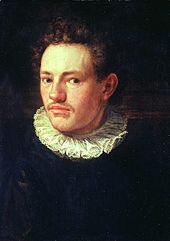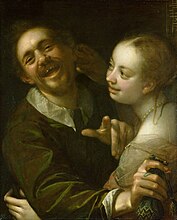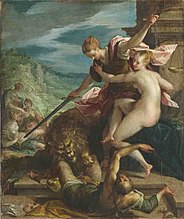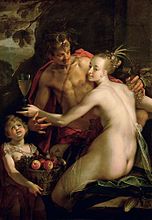Hans of Aachen

Hans von Aachen (* 1552 in Cologne , † 4. March 1615 in Prague ), and Johann von Aachen (after the birthplace of his father) or Jan van Achen , Aken or Janachen called, was a German , from the Rhineland -derived painter with the international career of a successful traveling artist and court painter .
Hans von Aachen lived and worked in Italy , Bavaria and Prague . In addition to numerous portraits , his works include above all allegorical , mythological and religious paintings as well as a large number of copperplate engravings and drawings .
Life
In his Schilder-Boeck , published in 1604, the painter and writer Karel van Mander reports that the young Hans von Aachen attracted attention early on because of his talent for drawing. His teacher in Cologne was an unknown painter, probably from Antwerp, from whom Aachen was trained according to the Flemish tradition.
Italy trip
Von Aachen left his hometown shortly after completing his apprenticeship and traveled south to Italy in 1574. There he initially moved to Venice and found work with the Antwerp painter and art dealer Gaspar Rem as well as support in the local community of Northern European dealers and artists . Within a year he traveled from Aachen to Rome. He stayed in the house of Anthonis Santvoort , where he refined his technique and found his own style in exchange with other painters such as Bartholomäus Spranger and Hans Speckaert . Although van Mander tells us that von Aachen painted a lot during this time, mainly drawings from this period have survived.
Meanwhile, von Aachen in Italy established a broad network of contacts with other artists, dealers and clients. He developed into a valued painter in the course of the 1580s, receiving significant commissions. In 1585 he worked in Florence at the court of the Grand Duke of Tuscany Francesco I de 'Medici . The commission to portray the Grand Duke was crucial for his advancement to court painter. Von Aachen's early portraits, with their loose brushstrokes and the brownish color palette, are still strongly influenced by Northern European painting. The self-portrait from around 1574 exhibited today in the Wallraf-Richartz Museum in Cologne is a good example of this. The combination of northern and southern European influences, which is evident in von Aachen's work at the end of his Italian period, is characteristic of his later painting. Another theme that runs through von Aachen's entire career is genre painting. He often uses his own smiling face, usually easily recognizable by his bad teeth, in depictions of exuberant couples or dome ice scenes.
In Bavaria

Around 1588, Hans von Aachen returned to Germany and settled in Munich. There he worked for the family of Duke Wilhelm V of Bavaria, for the Fuggers in Augsburg and created altarpieces for the Munich Jesuit order . Although von Aachen had already worked on religious paintings in Italy, it was precisely in Munich, characterized by the strict Catholic orientation of the ducal court, that he developed an iconography for his depictions that was strongly influenced by the ideas of the Counter-Reformation . Working with the Sadeler family of engravers and the miniature painter Joris Hoefnagel , he began to deal with copperplate engravings for the first time. Together they made a series of engravings with religious and allegorical motifs, some of which were based on von Aachen's previous paintings, but some were also first drafts. The spread of these engravings all over Europe contributed significantly to Hans von Aachen's fame.

While he was still working in Munich, von Aachen was appointed his chamber painter by Rudolf II , Emperor of the Holy Roman Empire, in 1592 . In 1594 the emperor raised him to the nobility and after von Aachen's marriage in Munich to Regina di Lasso, daughter of the famous composer Orlando di Lasso , the two moved to Prague together in 1596.
At the imperial court in Prague
Von Aachen's work in Prague can be seen as the high point of his work. However, the emperor not only valued his artistic talents: Van Mander writes that von Aachen “had an apellically friendly fellowship with this Alexander every day”, and that the emperor had “respect and appreciation”. This trust becomes clear in the diplomatic tasks with which the emperor entrusted his court painter. Rudolf II preferred to send him as a negotiator when it came to supplementing the imperial art collection. Von Aachen's expertise and the abundance of his contacts proved to be valuable help. The emperor also made use of his chamber painter when looking for a suitable bride. On the pretext that he was supposed to portray the young princesses, he sent from Aachen to the European royal courts, in order to receive detailed information from him about the local conditions and possible dowries. One of the rare direct characterizations that have come down from Aachen also belongs in this context. The ambassador of the d'Este , Girolamo Manzuolo, wrote in 1603: “He is a man of greater simplicity than intelligence, he does nothing, does not speak, gives and takes nothing, unless he immediately goes to his master at Heller and To give notice of everything; he is catholic, speaks a little Italian and is a truthful man who loves wine and happiness. "
The friendly relationship with Emperor Rudolf II led to the fact that Johann Aach was raised to the elite on November 1, 1594 and his previous coat of arms improved. On May 16, 1605, Johann von Aach had the elevation of the nobility confirmed again by the emperor and at the same time awarded the seal with red wax, the salva guardia and other freedoms.
As before, a number of portraits and religious paintings were created in Prague. More important, however, are the paintings with allegorical and mythological subjects , most of which were created directly for the imperial collections. Two special examples of his painting style of this time are the allegory of justice (Munich, Alte Pinakothek ) and Bacchus , Ceres and Amor (Vienna, Kunsthistorisches Museum ). Both pictures show a great interest in details and pastel colors, although the backgrounds vary: the first was painted on a small copper plate and the second on a relatively large canvas. Von Aachen mastered the techniques of working on different materials. His paintings on wood, canvas, copper, alabaster and black marble are known.
After the death of his patron Rudolf II on January 20, 1612 von Aachen stayed at the imperial court and continued his work for his brother and successor Matthias . His main occupation in the following years was painting portraits of the imperial couple. Hans von Aachen died three years later, on March 4, 1615, in Prague. His wife and five children moved back to Munich.
Meaning in its time
Von Aachen won the recognition of the European courts, the wealthy traders and merchants. The elevation to the nobility and his prominent position at the imperial court brought him influence and prestige. Already during his time in Italy he had students and assistants in his workshop. These included u. a. Pieter Isaacsz , Hans Holzmayer , Paul Schürer and Joseph Heintz the Elder . Only a few years after Hans von Aachen's death, the shadow of the Thirty Years' War fell over his work.
Newer reception
In the 19th century, a national perspective on art history dominated, so that Hans von Aachen's success as an international 'traveling artist' at the various courts of Europe was not recognized. Some commentators questioned von Aachen's existence. His works were repeatedly attributed to other artists such as Elsheimer , Caravaggio , Peter Paul Rubens and Annibale Carracci up until the 20th century .
More recently, the wide range of his themes and means of expression has led to a new and more intensive examination of his work. His desire to travel and his pluralism of styles are now considered to be an expression of an era of European cultural transfer.
Various exhibitions in the last few decades have shown the work of Hans von Aachen, but in each case in the context of Rudolfin's court culture. The two most important were the exhibitions Prague around 1600 - Art at the Court of Rudolf II (Essen, Villa Hügel , 1988) and Rudolf II and Prague - The Court and the City (Prague, Burggalerie, 1998).
The first exhibition took place in 2010, offering an overview of Hans von Aachen's entire oeuvre . Like the painter himself, she wandered through Europe and was on display in three different museums: from March 11th to June 13th, 2010, initially in the Suermondt Ludwig Museum in Aachen, and from July 1st to October 3rd in the Burggalerie in Prague and from October 19 to January 9, 2011 in the Kunsthistorisches Museum in Vienna.
Works (selection)
- The Raising of the Young Man by Nain, canvas, 1590, Alte Pinakothek (Munich)
- Allegory of Peace, Art and Wealth , 197 × 142 cm, 1602, Hermitage (Saint Petersburg) .
- Self-portrait , wood, around 1575, Wallraf-Richartz-Museum , (Cologne).
- Hunting scene , drawing, around 1585, Staatliche Kunstsammlungen Dresden , Kupferstichkabinett.
- Portrait of Francesco I de 'Medici, Grand Duke of Tuscany , canvas, 1585, Palazzo Pitti , Florence.
- The Martyrdom of St. Sebastian , canvas, 1589, Michaelskirche , (Munich).
- Portrait of Duke Wilhelm V of Bavaria , canvas, before 1589, Bavarian Administration of State Palaces, Gardens and Lakes (Munich).
- Amor Fucatus , engraving, 1591, Rijksmuseum (Amsterdam)
- The Coronation of Mariae , canvas, 1596, St. Ulrich and Afra Basilica (Augsburg).
- Young couple with a stock exchange , around 1596, canvas, 63 × 50 cm, Kunsthistorisches Museum , Vienna
- Allegory of Justice , copper, 56 × 47 cm, 1598, Alte Pinakothek (Munich).
- The Three Graces , canvas, ca.1604, Muzeul Național de Artă al României (Bucharest).
- Portrait of Emperor Rudolf II , canvas, 60 × 48 cm, around 1600, Kunsthistorisches Museum (Vienna).
- Bacchus, Ceres and Amor , canvas, 163 × 113 cm, around 1600, Kunsthistorisches Museum (Vienna).
- Allegory (triumph of rule over time) , oil on copper, around 1600, Staatsgalerie , Stuttgart.
- Adoration of the Shepherds , in the Lady Chapel of Dax Cathedral
-
Five allegories on the Long Turkish War of Emperor Rudolf II , around 1603/04, Kunsthistorisches Museum (Vienna)
- Battle of Sisseck on June 22, 1593 (Victoria crowns the seated Croatia) , oil on canvas, 34.5 × 42 cm
- Battle of Sibiu (glorification of victory over the bound uprising) , oil on canvas, 34.5 × 42 cm
- Battle of Kronstadt , oil on canvas, 34.5 × 42 cm
- The declaration of war before Constantinople , oil on canvas, 34.5 × 42 cm
- The conquest of Stuhlweissenburg , oil on canvas, 34.5 × 42 cm
literature
- Eduard Firmenich-Richartz : Achen (Aken), Johann von . In: Ulrich Thieme , Felix Becker (Hrsg.): General Lexicon of Fine Artists from Antiquity to the Present . Founded by Ulrich Thieme and Felix Becker. tape 1 : Aa – Antonio de Miraguel . Wilhelm Engelmann, Leipzig 1907, p. 40–42 ( Textarchiv - Internet Archive ).
- Benninghoff, Nora: Aachen, Hans von. In: New German Biography (NDB). Volume 1, Duncker & Humblot, Berlin 1953, ISBN 3-428-00182-6 , p. 1 ( digitized version ).
- Eliška Fučíková: Life. In: Hans von Aachen, Court Artist in Europe - exhibition catalog. German Art Publishing House, 2010.
- Joachim Jacoby (editing): The New Hollstein German Engravings, Etchings and Woodcuts 1400–1700 - Hans von Aachen (Ed .: Ger Luijten, Robert Zijlma), Sound & Vision Interactive, Rotterdam 1996.
- Joachim Jacoby: Hans von Aachen 1552-1615. Deutscher Kunstverlag, Munich & Berlin 2000.
- Claudia Reichl-Ham: The "Long Turkish War" of Rudolf II and its reception in the Army History Museum. In: Viribus Unitis. Annual report 2007 of the Army History Museum. Vienna 2008, pp. 11–34.
- Karel Van Mander: Het Schilder-Boeck, Amsterdam 1604. Fol. 289v-291r.
- Julius Meyer : Achen, Johann von . In: Allgemeine Deutsche Biographie (ADB). Volume 1, Duncker & Humblot, Leipzig 1875, p. 29.
Web links
- Exhibition page of the first major retrospective by Hans von Aachen - The exhibition is a collaboration between the Suermondt Ludwig Museum , the Castle Gallery in Prague and the Museum of Art History
- Getty Museum - Short Biography
- Literature by and about Hans von Aachen in the catalog of the German National Library
- Hans von Aachen, copper engravings , on portal tripota.uni-trier.de, accessed on November 29, 2015
- Hans von Aachen in Google Arts & Culture
Individual evidence
- ^ Friedrich Müller: The artists of all times and peoples. 1857 ( textlog.de , accessed on May 26, 2013).
- ↑ Van Mander's Schilder-Boeck from 1604, published in Haarlem in 1604 (reprinted in 1617), is one of the most important sources for the life of Dutch artists, including Frans Floris de Vriendt I (1516–1570), who was probably published by Hans von Aachen in the Teaching went.
- ^ Jacoby: Hans von Aachen. 2000, p. 25 f.
- ↑ Fučíková: Das Leben 2010 (manuscript p. 7 f).
- ^ A. Venturi: On the history of the art collections of Emperor Rudolf II . In: Repertory for Art History. 8, 1885, pp. 1-23, p. 10.
- ↑ AT-OeStA / AVA Adel RAA 1.3.
- ↑ AT-OeStA / AVA Adel RAA 1.4.
- ↑ Schürer, Paul . In: Hans Vollmer (Hrsg.): General lexicon of fine artists from antiquity to the present . Founded by Ulrich Thieme and Felix Becker . tape 30 : Scheffel – Siemerding . EA Seemann, Leipzig 1936, p. 312 .
- ↑ Fučíková: Life. 2010 (manuscript p. 4).
- ^ Jacoby: Hans von Aachen. 2000, p. 65 f.
- ↑ Allegory of Peace, Art and Wealth zeno.org.
- ^ Ina Conzen: Staatsgalerie Stuttgart, the collection: Masterpieces from the 14th to the 21st century. Hirmer, Munich 2008, ISBN 978-3-7774-7065-8 .
| personal data | |
|---|---|
| SURNAME | Aachen, Hans von |
| ALTERNATIVE NAMES | Aachen, Johann von; Achen, Jan van; Aken; Janaches |
| BRIEF DESCRIPTION | German painter |
| DATE OF BIRTH | 1552 |
| PLACE OF BIRTH | Cologne |
| DATE OF DEATH | March 4, 1615 |
| Place of death | Prague |



